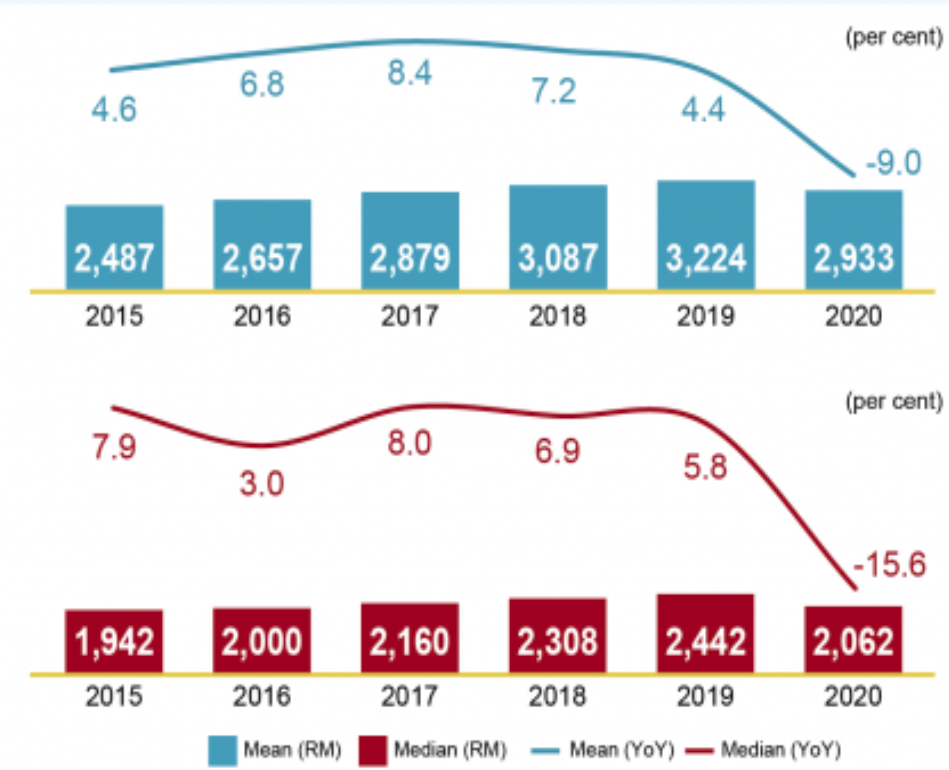Survey: Malaysia's Average Income Sees First Negative Drop In 11 Years
People with primary education levels had the biggest drop in median salaries and wages last year.
Malaysia's median income recorded a negative growth for the first time ever since the annual national survey on the citizens' income level began 11 years ago
Today, 14 July, the Department of Statistics Malaysia (DOSM) released its annual Salaries & Wages Survey Report for the year 2020.
According to the survey, Malaysia's monthly median salaries had decreased by 15.6% from RM2,442 to RM2,062 last year.
Meanwhile, Malaysia's monthly average salaries had decreased by 9% from RM3,224 to RM2,933.
For the past five years before 2020, the median salaries increased by an average of 6.32%, while the average salaries increased by an average of 6.28%.
It is worth noting that the distinction between median and average — also known as mean — is crucial when it comes to understanding the income level of a population.
The median income is widely considered to be the more accurate depiction of a population's income level because it reflects both the total income and the income distribution, while mean income reflects only the total income.
Based on its data, semi-skilled workers suffered the worst drop in monthly median salaries and wages
Semi-skilled workers suffered a 16.15% in pay drop from RM1,900 to RM1,593, while high-skilled workers and low-skilled workers suffered a pay drop of 10.22% (from RM4,468 to RM4,011) and 10.4% (RM1,422 to RM1,274) respectively.
Below is the breakdown of the drop of median salaries and wages by different age groups:
15-24: 17% — from RM1,520 to RM1,253
25-34: 15% — from RM2,415 to RM2,054
35-44: 2% — from RM2,996 to RM2,926
45-55: 10% — from RM3,021 to RM2,718
54-65: 17% — from RM2,736 to RM2,268
The youngest and oldest age groups suffered the biggest percentage drop in their median income, while people between the ages of 35 and 44 suffered only a 2% decrease in their median income.
People living in urban areas reported a higher decrease in median salaries and wages
DOSM illustrated that people living in urban areas lost 9.2% in median salaries from RM3,405 to RM3,089, while people living in rural areas lost 5.5% in median salaries from RM2,208 to RM2,086.
People working in the agriculture sector underwent the highest average pay cut at 20%, followed by the mining and quarrying sector at 17.7%, the construction sector at 10.4%, and the servicing sector at 9.4%.
Below is the breakdown of the drop of median salaries and wages by different education levels:
Tertiary: 10.3% — from RM3,901 to RM3,499
Secondary: 16.6% — from RM1,955 to RM1,630
Primary: 18.3% — from RM1,560 to RM1,274
No formal education: 13.8% — from RM1,436 to RM1,237
People with primary education levels had the biggest drop in median salaries and wages.
As for the total number of recipients of salaries and wages, DOSM said it grew at a slower rate of 2.1% to 9.4 million people last year.
In comparison, 2019 underwent a growth of 5% to 9.2 million people.
DOSM contributed the overall drop in salaries and wages to the effects of the COVID-19 pandemic and the implementation of the Movement Control Order (MCO) in the country throughout 2020.


